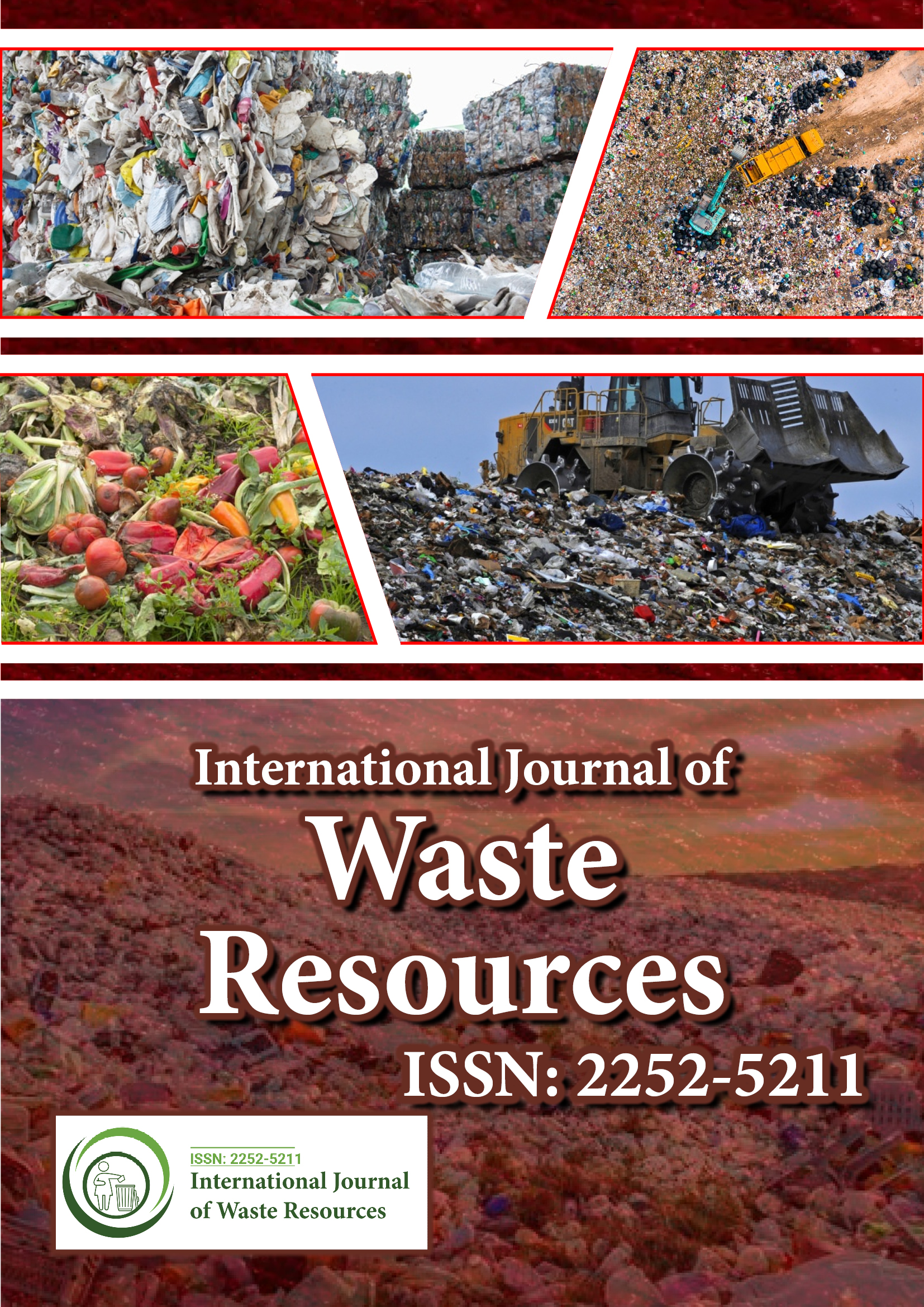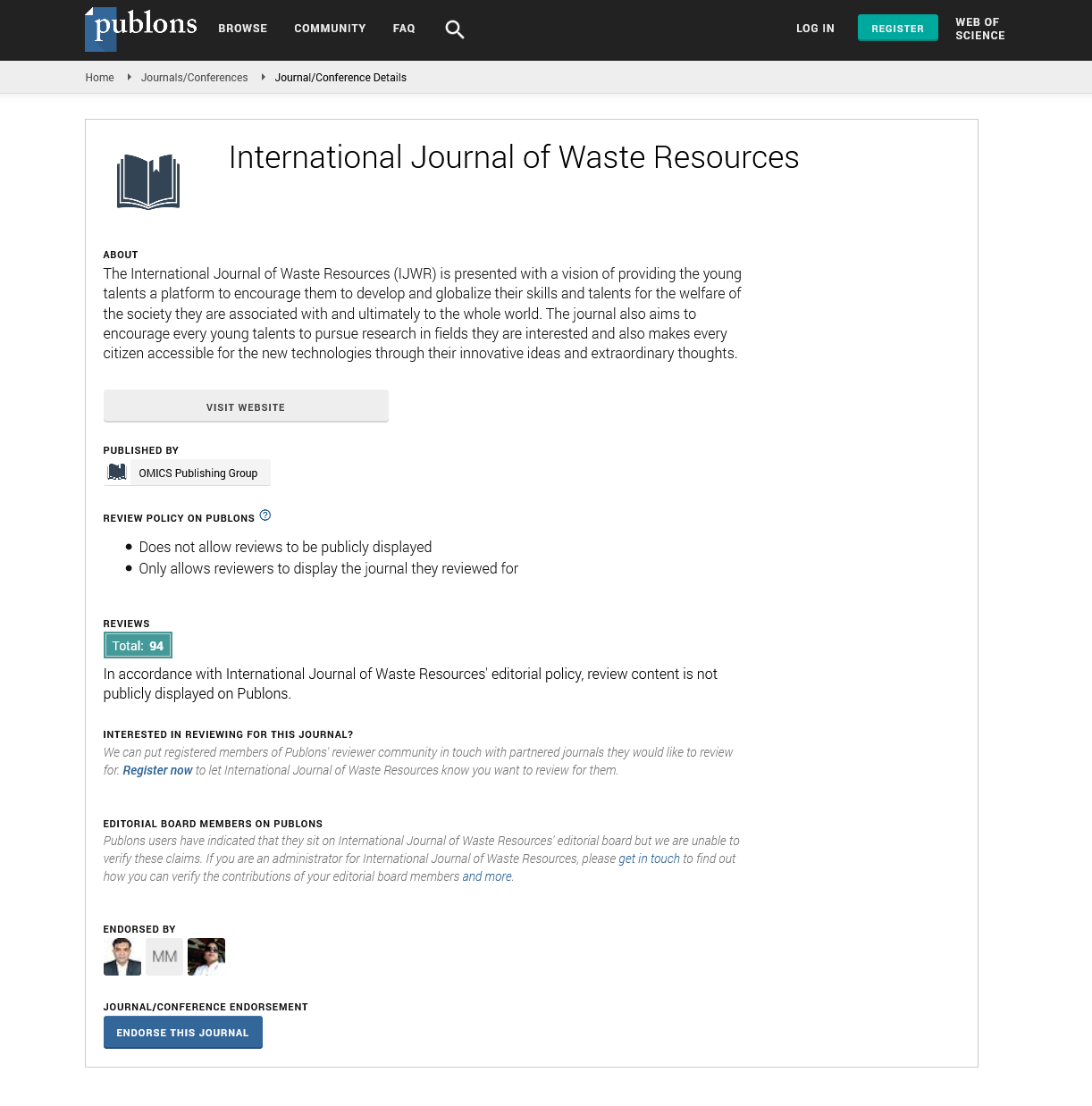Indexed In
- Open J Gate
- The Global Impact Factor (GIF)
- Open Archive Initiative
- VieSearch
- International Society of Universal Research in Sciences
- China National Knowledge Infrastructure (CNKI)
- CiteFactor
- Scimago
- Ulrich's Periodicals Directory
- Electronic Journals Library
- RefSeek
- Directory of Research Journal Indexing (DRJI)
- Hamdard University
- EBSCO A-Z
- Publons
- Google Scholar
Useful Links
Share This Page
Journal Flyer

Open Access Journals
- Agri and Aquaculture
- Biochemistry
- Bioinformatics & Systems Biology
- Business & Management
- Chemistry
- Clinical Sciences
- Engineering
- Food & Nutrition
- General Science
- Genetics & Molecular Biology
- Immunology & Microbiology
- Medical Sciences
- Neuroscience & Psychology
- Nursing & Health Care
- Pharmaceutical Sciences
Articles published in International Journal of Waste Resources have been cited by esteemed scholars and scientists all around the world. International Journal of Waste Resources has got h-index 29, which means every article in International Journal of Waste Resources has got 29 average citations.
Following are the list of articles that have cited the articles published in International Journal of Waste Resources.
| 2024 | 2023 | 2022 | 2021 | 2020 | 2019 | 2018 | 2017 | 2016 | 2015 | 2014 | 2013 | 2012 | 2011 | |
|---|---|---|---|---|---|---|---|---|---|---|---|---|---|---|
Total published articles |
37 | 60 | 60 | 57 | 23 | 10 | 42 | 60 | 69 | 22 | 46 | 14 | 10 | 4 |
Research, Review articles and Editorials |
2 | 9 | 5 | 28 | 20 | 7 | 9 | 53 | 60 | 22 | 35 | 12 | 10 | 4 |
Research communications, Review communications, Editorial communications, Case reports and Commentary |
20 | 51 | 55 | 29 | 3 | 3 | 1 | 7 | 9 | 0 | 11 | 2 | 0 | 0 |
Conference proceedings |
0 | 44 | 0 | 0 | 0 | 0 | 62 | 54 | 89 | 0 | 0 | 0 | 45 | 0 |
Citations received as per Google Scholar, other indexing platforms and portals |
486 | 620 | 719 | 709 | 534 | 419 | 314 | 206 | 143 | 115 | 44 | 15 | 0 | 0 |
| Journal total citations count | 4450 |
| Journal impact factor | 1.79 |
| Journal 5 years impact factor | 2.53 |
| Journal cite score | 13.83 |
| Journal h-index | 29 |
Important citations
Shivaprasad KN, Das BB. Determination of optimized geopolymerization factors on the properties of pelletized fly ash aggregates. Construction and Building Materials. 2018 Feb 28;163:428-37.
Borgatta J, Paskavitz A, Kim D, Navea JG. Comparative evaluation of iron leach from different sources of fly ash under atmospherically relevant conditions. Environmental Chemistry. 2016 Jan 1;13(5):902-12.
Adegoke KA, Oyewole RO, Lasisi BM, Bello OS. Abatement of organic pollutants using fly ash based adsorbents. Water Science and Technology. 2017 Nov 23;76(10):2580-92.
Shreya N, Valentim B, Paul B, Guedes A, Pinho S, Ribeiro J, Ward CR, Flores D. Multi-technique study of fly ash from the Bokaro and Jharia coalfields (Jharkhand state, India): a contribution to its use as a geoliner. International Journal of Coal Geology. 2015 Dec 1;152:25-38.
Ahmad MA, Shahnawaz M, Siddiqui MF, Khan ZH. A statistical review on the current scenario of generation and utilization of fly-ash in India. International Journal of Current Engineering and Technology. 2014;4(4):2434-8.
Tripathy AK, Sarangi CK, Tripathy BC, Sanjay K, Bhattacharya IN, Mahapatra BK, Behera PK, Satpathy BK. Aluminium recovery from NALCO fly ash by acid digestion in the presence of fluoride ion. International Journal of Mineral Processing. 2015 May 10;138:44-8.
Streets DG, Lu Z, Levin L, ter Schure AF, Sunderland EM. Historical releases of mercury to air, land, and water from coal combustion. Science of the Total Environment. 2018 Feb 15;615:131-40.
Banerjee S, Sharma GC, Chattopadhyaya MC, Sharma YC. Kinetic and equilibrium modeling for the adsorptive removal of methylene blue from aqueous solutions on of activated fly ash (AFSH). Journal of Environmental Chemical Engineering. 2014 Sep 1;2(3):1870-80.
Dananjayan RR, Kandasamy P, Andimuthu R. Direct mineral carbonation of coal fly ash for CO2 sequestration. Journal of cleaner production. 2016 Jan 20;112:4173-82.
Arab G. Integration of Anaerobic Digestion and Composting Facilities.
Pan TH, Chen TB, Gao D, Zheng GD, Chen J, Zhou HB. Comparison of cassava distillery residues and straw as bulking agents for full-scale sewage sludge composting. Compost Science & Utilization. 2017 Jan 2;25(1):1-2.
Pan TH, Chen TB, Gao D, Zheng GD, Chen J, Zhou HB. Comparison of cassava distillery residues and straw as bulking agents for full-scale sewage sludge composting. Compost Science & Utilization. 2017 Jan 2;25(1):1-2.
Arab G, McCartney D. Benefits to decomposition rates when using digestate as compost co-feedstock: Part I–Focus on physicochemical parameters. Waste management. 2017 Oct 1;68:74-84.
Essa AM, Khallaf MK. Antimicrobial potential of consolidation polymers loaded with biological copper nanoparticles. BMC microbiology. 2016 Dec;16(1):144.
Kitching M, Butler R, Marsili E. Microbial bioelectrosynthesis of hydrogen: current challenges and scale-up. Enzyme and microbial technology. 2017 Jan 1;96:1-3.
Essa AM, Khallaf MK. Biological nanosilver particles for the protection of archaeological stones against microbial colonization. International Biodeterioration & Biodegradation. 2014 Oct 1;94:31-7.
Agyarko-Mintah E, Cowie A, Van Zwieten L, Singh BP, Smillie R, Harden S, Fornasier F. Biochar lowers ammonia emission and improves nitrogen retention in poultry litter composting. Waste management. 2017 Mar 1;61:129-37.
Vandecasteele B, Sinicco T, D'Hose T, Nest TV, Mondini C. Biochar amendment before or after composting affects compost quality and N losses, but not P plant uptake. Journal of Environmental Management. 2016 Mar 1;168:200-9.
SpychaÅ‚a M, Pawlak M, Nawrot T. Capacity of textile filters for wastewater treatment at changeable wastewater level–a hydraulic model. Acta Scientiarum Polonorum. Formatio Circumiectus. 2016;15(4):421.
AHMED SB. Decentralized Treatment of Domestic Wastewater Using Membrane Based Septic Tank (MBST) (Doctoral dissertation, IESE (SCEE) NUST).

